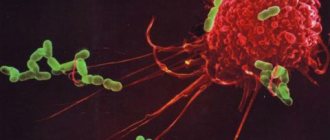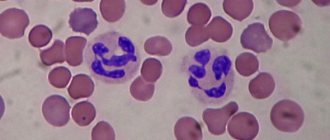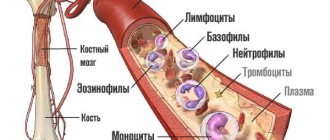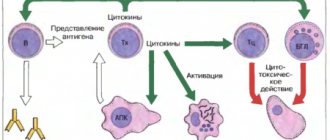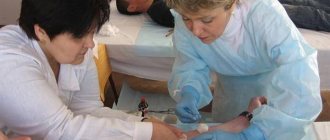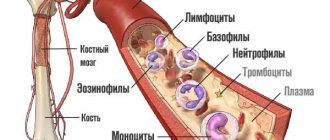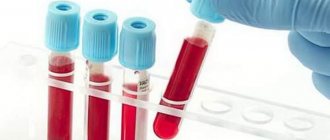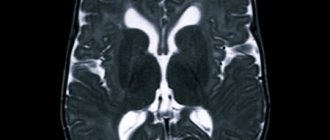Of course, blood tests play a significant role in diagnosing diseases. Knowing the participation of different types of leukocytes in the life of the body allows us to timely identify abnormalities and suspect pathology.
Band neutrophils are part of a large group of granulocytes and are precursors or younger (they are also called “young”) cells of the segmented type. They differ from their successors by having an undivided core of an oblong or twisted structure.
Doctors call them “sticks”, and if they are angry, “sticks”. Doctors of all specialties are familiar with the indicator.
What it is
Leukocytes are divided into several types. The most numerous of them are neutrophils. They are produced by the bone marrow. These cells are essential for the normal functioning of the immune system. When an infectious agent, allergen or toxin enters the body, neutrophils are sent to the lesion. They attack foreign protein and digest it. In this case, neutrophils die, but new protective cells are formed in their place.
During maturation, each neutrophil goes through several stages:
- myeloblast;
- promyelocyte;
- metamyelocyte;
- band neutrophil;
- segmented neutrophil.
Segmented neutrophils are mature cells. They are able to move freely in the bloodstream and fully fight infectious agents, allergens and toxins. The nuclei of such cells have a segmented shape.
Band neutrophils are a young form of cells. Otherwise, they are called young or immature neutrophils. The nuclei of young cells are rod-shaped. Such neutrophils cannot yet reach the lesion and destroy foreign agents. Subsequently, band neutrophils mature into segmented neutrophils.
What does the analysis for band neutrophils show?
Band cells are a type of leukocyte. Neutrophils of this type perform a protective function in the human body. When any foreign agents enter the body, cells quickly destroy them and then die.
The place of dead neutrophils is taken by newly formed ones. Such cells are immature, which means they cannot cope with strong and resistant microorganisms.
Additionally, rod cells take an active part in the process of fibrinolysis and also supply substances that have an antitoxic effect to the body. When examining blood, specialists pay special attention to the level of these neutrophils, as this allows them to detect the first signs of inflammation, poisoning and other pathological conditions.
The test for band neutrophils helps the specialist assess the ability of the patient’s immune system to fight various pathogens. The result allows you to determine the direction of further examination, as well as draw up a preliminary treatment regimen.
The role of rods in the body
Rods in the blood usually appear at the very beginning of an inflammatory disease, when there are no obvious symptoms of the pathology. When a foreign agent enters the body, the bone marrow releases young neutrophils into the bloodstream. The main task of these cells is to mature into a segmented form, and then begin to fight an infection or toxin.
When the rods turn into mature neutrophils, a person experiences severe symptoms of an inflammatory reaction and an increase in temperature. This is a sign that the segmented cells have begun to attack a foreign protein.
Types of analysis
There are two types of general blood test (CBC):
- Without leukocyte formula. In this case, only the total level of white and red blood cells, hemoglobin, as well as the ESR reaction are determined. This study does not show the concentration of each type of leukocyte in the blood.
- With leukocyte formula. In addition to the indicators of red blood cells, hemoglobin and ESR, the analysis determines the level of each type of white blood cells, including the number of band and segmented cells.
If you need to find out the level of bacilli in the blood, then you need to get a referral from your doctor for a blood test with a detailed breakdown of the leukocyte formula.
Causes of a low number of neutrophils in an adult
Changes in the level of mature or immature neutrophils are detected when reading a blood test. At the same time, indicators such as monocytes and lymphocytes are compared and analyzed. A sharp decrease in band neutrophils in an adult is present with the following serious anomalies, such as:
- thrombocytopenia;
- metastases in the bone marrow;
- leukemia;
- ulcerative lesions of the stomach and duodenum;
- poisoning;
- consequences of radiation treatment.
Long-term use of penicillin antibiotics, as well as analgesics based on metamizole sodium, helps reduce the level of neutrophils. With low levels of rod and segmented cells, a pregnant woman is at risk of miscarriage. Only a doctor can determine the exact cause of a decrease in any type of neutrophils after additional examination.
Preparing for the study
Capillary blood is taken from a finger for analysis. In order for the test results to be reliable, you need to properly prepare for the study:
- 2 days before the test, avoid spicy and fried foods.
- Before the analysis, you must not smoke for several hours.
- Do not drink alcohol the night before the test.
- Avoid strenuous physical activity.
- Don't get too cold.
- Avoid taking medications. If you have to take medications constantly, you must inform your doctor about this.
- If the patient has undergone tooth extraction, or has undergone endoscopy of the gastrointestinal tract, then the test can be taken no earlier than 7 days after the procedure. Otherwise, an erroneous number of leukocytes may be detected in the blood.
It is recommended to take the test on an empty stomach. Eating is allowed 8 hours before the procedure.
How to determine the level
Neutrophils in a child can be examined in the following ways:
- clinical blood test;
- blood chemistry;
- bone marrow biopsy.
General blood analysis
The quantitative composition of neutrophils can be determined using a complete blood count (CBC), because these white blood cells quickly respond to changes in the body.
In order for the research result to be accurate, the following rules must be followed:
- take the test on an empty stomach;
- for several days before taking the OAC, do not eat spicy and fried foods, as well as foods with preservatives and food additives;
- if possible, do not take medications;
- avoid intense muscle activity;
- ensure a stable emotional state;
- avoid sudden changes in temperature.
During the OAC test, there should be no wounds, scratches, cuts or other damage to the skin. If the child has been vaccinated, then the OAC can be taken after 1-4 weeks.
Blood chemistry
If neutrophils in the blood of children differ greatly from the norm in the direction of increase (neutrophilia, shift of the leukocyte formula to the left), and such a deviation persists for a long time, then additional research should be carried out. A biochemical blood test (BAC) allows you to clarify and expand the information.
Important information: What does reduced hematocrit mean during pregnancy in the 1st-3rd trimester
Blood is drawn from a vein. The rules for preparing for the test are the same as for the OAC.
Bone marrow biopsy
The study is carried out if a strong and stable deviation from acceptable indicators is detected. The indication for analysis is a condition in which the norm of young cells is exceeded by 5% against the background of the absence of a history of the following factors:
- intoxication;
- chronic infectious disease;
- irradiation;
- blood loss;
- chronic stress;
- taking specific medications.
If the norm of neutrophils in children is exceeded by more than 10%, this may indicate the development of blood cancer. At concentrations below normal levels, chromosomal disturbances in the synthesis of blood cells are possible.
The biopsy is performed in an outpatient clinic or hospital using local anesthesia.
If the baby is 1 year or younger, then the biomaterial is taken from the femur, tibia or calcaneus. In older children - from the pelvic bone.
Normal in children
In children, normal indicators of band cells are significantly higher than in adults. The table below shows reference values for the concentration of rods depending on age.
| Child's age | Rod concentration (%) |
| Up to 3 months | 7-15 |
| 3 – 6 months | 3-8 |
| From six months to a year | 2-7 |
| 16 years | 1-6 |
| 6 – 14 years | 1-5 |
Reasons for deviations
If the level of rods in the blood is elevated, this indicates pathology. This deviation is called neutrophilia. In adult patients, this may be due to the following reasons:
- viral inflammation in the upper respiratory tract;
- diabetes mellitus;
- allergies;
- inflammatory kidney pathologies;
- diseases of the stomach and intestines.
If “low” bacilli are detected in the blood, doctors call this deviation neutropenia. In adults, this indicates that the body has chronic inflammation. In this case, the supply of rod cells is depleted due to the long-term fight against infection. Neutropenia is also observed with a sharp decrease in immunity and in cancer patients after chemotherapy.
In addition, neutropenia may be a physiological feature of a given patient. In this case, the results of the analysis do not indicate pathology. There is also a cyclic decrease in band neutrophils, which lasts 2 to 3 days. Then the blood counts return to normal. This feature is genetic in nature.
If bacilli in a child’s blood are elevated, this indicates the following pathologies:
- gastrointestinal diseases;
- helminth infestation (ascariasis, infection with flatworms);
- inflammatory processes in the throat, sinuses and ears.
Neutropenia in childhood may be due to the following reasons:
- fungal infection;
- viral pathologies (hepatitis, measles, influenza);
- severe intoxication with drugs or chemicals;
- anemia;
- vitamin deficiency;
- exposure to radiation (including chemotherapy).
A decrease in the concentration of rods in the blood of a baby is a dangerous symptom. This suggests that the child’s body resistance is sharply reduced. If the analysis reveals elevated lymphocytes along with neutropenia, this indicates a severe inflammatory process.
However, in some cases, neutropenia is not a sign of the disease. The analysis may give false results due to the use of analgesics. Therefore, it is necessary to inform the doctor about all medications the patient is taking.
Quantity change
Deviations in the number of PN neutrophils from normal values are directly related to fluctuations in the total content of leukocytes and, in particular, granulocytes. After all, all five components of the leukocyte formula (neutrophils, lymphocytes, basophils, eosinophils and monocytes) are directly involved in the implementation of immune defense.
Therefore, when faced with alien objects, they undergo changes to varying degrees. The need to increase the level of the immune response and the beginning of the fight against pathogens causes a corresponding increase in the production of young neutrophils and their subsequent maturation into segmented functionally capable cells.
After a few days, the SCs die when interacting with the infection, and they are replaced by new ones that grow from rod cells. A general decrease in the number of neutrophils is always reflected in a decrease in the number of PNs, and sometimes their complete absence in the blood can be observed.
Reference! A low level of neutrophils, or neutropenia, or an increase in them, which is called neutrophilia, necessarily affects the level of young cells, and this can be observed when reading a blood test.
Neutropenia and complete absence of young neutrophils
The main causes of severe neutropenia, or a condition in which immature cells are completely absent, are in most cases due to excessive consumption (suppression) of the production of components of the leukocyte formula.
As a rule, such consequences are typical for severe pathologies, including the following:
- viral infections leading to an increase in the synthesis of lymphocytes and monocytes and suppression of neutrophil production (diphtheria, measles, rubella, scarlet fever, influenza in children, hepatitis);
- bacterial infections (tularemia, chronic brucellosis, typhoid and paratyphoid fever);
- toxic effects of medications on the cell production process (analgesics, immunosuppressants, sulfonamides, interferon);
- aplastic anemia or caused by a lack of vitamin B12 or folic acid;
- hereditary predisposition or congenital anomaly in children, anaphylactic shock;
- radiation effects, as well as the effects of radiation and chemotherapy for cancer and leukemia.
It is extremely rare for newborns to experience a complete absence of neutrophilic leukocytes. This pathology is a very severe congenital disease and is called Kostman neutropenia.
A person suffering from this disease experiences frequent inflammatory diseases - purulent formations in the oral cavity, on the skin and in the rectum. In addition to the decrease in neutrophils, the analysis also noted a decrease in the content of monocytes and eosinophils.
It should be noted that in absolutely all cases, a decrease in the number of neutrophils and the absence of their immature forms means a general weakening of the vital forces of the body and specifically a suppression of immune function. If in childhood the body does not have sufficient natural protection against harmful microorganisms, then the likelihood of mortality in this case is very high.
Reasons for the growth of the indicator
All of the above information indicates that if PN neutrophils increase, this means that an inflammatory process is developing in the body. Mature neutrophils absorb microbes and die, and decay products soften the tissues surrounding the affected area, thereby causing them to suppurate.
Therefore, the purulent process is the main sign of the growth and active activity of neutrophils. It can occur in various forms - in the form of sinusitis, purulent wounds or plaque on the tonsils, otitis, inflammation of the digestive or respiratory system and other painful manifestations for patients.
The list of pathogens that can cause an inflammatory process is quite wide. It includes streptococcus, staphylococcus, E. coli, protozoa, salmonella, Koch's bacillus, etc. Since PN cells are synthesized at the very beginning of the onset of the disease and they need a certain time to finally mature, the increase in the indicator can be asymptomatic.
But when they mature and begin to function fully, the clinical picture of inflammation gradually increases, which consists of the following manifestations:
The norm of leukocytes in the blood of newborns
- redness of the skin or mucous membranes;
- swelling, fever, headache;
- fatigue and poor general condition;
- soreness of the affected areas;
- purulent discharge.
Against the background of common reasons that can increase the level of neutrophils in the following diseases:
- fungal and viral infections (arthritis, rheumatism, genitourinary diseases);
- severe intoxication due to lead, mercury poisoning or high blood sugar;
- pathologies of the hematopoietic system (leukemia).
When conducting diagnostics, special attention is paid to the content of band cells.
Reference! Pregnancy, labor and other physical activity can lead to an increase in the total number of neutrophils, but the level of neutrophils will not go beyond normal limits.
In addition, the number of all leukocytes in the blood, including band ones, can be increased with a decrease in the quality of nutrition and an unhealthy lifestyle. For example, an unbalanced diet negatively affects a person’s overall health, including his immune system.
Vivid emotional shocks (even positive ones) or excessively active games in children can also increase the rate. Also, their neutrophil levels may rise after colds, vaccinations, and even when teething. But these changes are temporary and physiological in nature, so there is no need to worry too much, as they quickly return to normal.
The most common pathological reasons that result in increased band neutrophils include the following:
- purulent diseases of the skin and subcutaneous tissue (phlegmon, abscesses);
- pathologies of the hematopoietic system;
- severe sore throats;
- septic conditions.
Purulent tonsillitis is almost always accompanied by the growth of band neutrophils
An increase in the rate of over 6% is called a shift in the leukocyte formula to the left, that is, towards immature cells. Quite rarely, but still, elevated PN neutrophils are observed in the following cases:
- in acute myocardial infarction;
- malignant neoplasms;
- skin diseases;
- trophic ulcers;
- stroke.
If the indicator is zero
In some cases, the patient completely lacks rods in the blood. What does it mean? A zero reading may indicate the following pathologies:
- dangerous diseases of bacterial etiology (brucellosis, tularemia, typhus and typhoid fever, diphtheria);
- viral pathologies that occur in severe form (measles, influenza, rubella);
- poisoning with medications or chemicals;
- radiation sickness;
- malignant tumors;
- bone marrow pathologies;
- vitamin deficiency B12;
- severe anemia.
A zero concentration of band neutrophils is called agranulocytosis. This condition always indicates a serious problem in the body.
The absence of rods in a child’s blood may indicate congenital neutropenia. Such children should be registered with a doctor. They are very susceptible to infections: pneumonia and purulent inflammation. Diseases in such children are very difficult.
Table by age
The source of information about the number of neutrophils is a detailed general blood test.
The normal content of these cellular structures for healthy people depends on the age group they belong to. Relative values of normal levels for all age groups are presented in the table.
| Patient age | Band neutrophils (%) |
| Newborns | 3—17 |
| Children from 1 month to 1 year | 0,5—4 |
| Children from one to 13 years old | 0,7—5 |
| Teenagers (13-15 years old) | 1—6 |
| Men | 1—6 |
| Women | 1—6 |
Normal for women
The table by age shows the relative norms for women in the range of 1 - 6 percent. The absolute normal values for women are 1.8-6.5 × 109 cells per liter.
Is there any cause for concern if the number of band neutrophils does not exceed 6 percent? What does this mean? First of all, there is no health-threatening bacterial infection. In other words, at this moment the bone marrow is not active, sending young neutrophils into the blood vessels.
Types of neutrophils
But what happens if a blood test shows a quantitative increase in leukocytes of this type (above 6 percent in women)? Perhaps the patient is sick. This situation occurs in a number of diseases and conditions, including
- leukemia;
- inflammation in the ear, bronchi, tonsils, lungs;
- blood poisoning;
- peritonitis;
- burns;
- abscess;
- trophic ulcers.
Rod-shaped neutrophils in men
If in the leukocyte formula of healthy adults, regardless of gender, band neutrophils make up from 1 to 6%, this is the norm. The absolute levels of immature neutrophils in the blood of men are 1.8-6.5 × 109 units per liter. These same values are the norm for women. In other words, the norm is for all adults.
In the child's blood
The normal number of young neutrophils corresponds to the age of the babies. The maximum acceptable value in infants (up to 17 percent) is much higher than in healthy older children (band neutrophils no more than 4-5 percent).
The norm differs noticeably only in the initial period of the baby’s life, when the mother’s blood cells change to new, the child’s own blood components.
Deviations from the norm in children:
- Neutrophils are reduced or completely absent in the child’s blood, and no noticeable deterioration in well-being is observed. If a repeat test shows the same results (insignificant or 0 in the child), the pediatrician diagnoses benign neutropenia of childhood and recommends contacting a hematologist and immunologist. The causes of this disease have not been studied, but it does not require special therapy. The level of neutrophils levels out on its own by 1 year, and sometimes by two.
- In the analysis of a completely healthy child, there are moderately increased values of the level of leukocytes in this group. This happens if shortly before blood sampling the baby suffered from an illness or simply had a hearty breakfast.
During pregnancy
Often, pregnant women have an increased level of bacilli in the blood. The reason for this is the body's reaction to the embryo. The immune system recognizes the fetus as a foreign body. As a result, the bone marrow releases large numbers of immature neutrophils into the blood. As pregnancy progresses, the level of rods increases.
If the woman feels well, then this should not be a cause for concern. However, if the patient has signs of inflammation or a persistently elevated temperature, then it is necessary to undergo additional diagnostics. It is important to remember that infectious diseases during pregnancy are very dangerous.
Reasons for the decline in indicators in children and adults
If there is a decrease in the blood cells in question, this indicates a severe course of some disease. In this case, a so-called neutrophil overconsumption occurs. This condition is accompanied by a weakened immune system and requires immediate medical treatment of the underlying pathology. Neutrophils are reduced in adults or children with the following diseases:
What to do if there are deviations from the norm
The concentration of rods in a blood test only indicates various pathologies. It is impossible to increase or decrease the level of immature cells using special tablets. It is necessary to cure the underlying disease, and then the sticks will return to normal.
To identify the etiology of neutrophilia or neutropenia, the doctor may prescribe additional tests:
- Ultrasound of internal organs;
- tests of smears from ENT organs for bacterial culture;
- gynecological smear;
- PCR diagnostics;
- fecal analysis for helminth eggs.
- examination by an otolaryngologist.
Most often, an increase or decrease in immature cells is associated with inflammatory diseases of a bacterial, viral or fungal nature. In this case, the doctor prescribes antibiotics, corticosteroids, and immunomodulators.
The most dangerous are neutropenia caused by radiation, severe anemia, bone marrow diseases and tumors. In this case, the patient needs to prepare for long-term treatment.
If deviations are caused by random reasons, then it is necessary to eliminate the unfavorable factor. For example, if neutropenia is associated with vitamin deficiency, you need to reconsider your diet and stop following a strict diet. If your blood pressure levels are low due to medication, you should consult a doctor and consult about replacing the drug with a more gentle one. This will help bring your blood counts back to normal.
Why deviations occur
If increased band neutrophils are observed in the blood, the presence of neutrophilia is noted, which indicates the development of a pathological process in the body. White blood cells may have low values, which often signals a weak immune system or a depleted state of the body. Often neutrophils have low levels as a result of a recent severe and prolonged illness.
Most of these cells are concentrated in the bone marrow, and blood in the vessels accounts for about 30%. Neutrophils in the blood increase as a result of the presence of the following pathologies:
- viral diseases of the upper respiratory tract;
- diabetes mellitus of the first and second types;
- burns of the skin or mucous membranes;
- kidney diseases;
- problems with the functioning of the gastrointestinal tract;
- manifestation of various allergic reactions.
In addition, there may be additional cases where band neutrophils are elevated, the reasons for this deviation from the norm are as follows:
- inflammatory and purulent processes;
- intoxication with life-threatening substances and metals - mercury, benzene, lead;
- malignant tumors;
- blood pathologies;
- severe frostbite.
Neutrophil cells are responsible for protecting the body from pathogenic bacteria and infections. Therefore, when a foreign body penetrates, their active growth is observed.
Neutropenia, or a decrease in neutrophils, may indicate a chronic pathology and a decrease in the body's resistance to viruses, bacteria, and infectious pathogens.
The following types of neutropenia are distinguished:
- benign type - is an individual feature of the body;
- cyclic type - manifests itself in certain periods and persists for some time;
- Kostmann's neutropenia is a genetically determined pathology.
A person may inherit a decrease in neutrophil levels. Therefore, frequent diseases with Kostmann neutropenia are pneumonia, purulent inflammation and other bacterial pathologies.
Important information: What does it mean to have a hematocrit reduced or below normal in the blood of an adult and what does the indicator mean?
Sometimes the test result shows a value of “neutrophils 0” in an adult. The zero mark of these cells may indicate the following pathologies:
- presence of bacterial diseases;
- the presence of viral diseases;
- anemia;
- negative effects of radioactive radiation on the body.
If the blood test results show “neutrophils 1” in an adult, then the cell level is most likely within the normal range.
